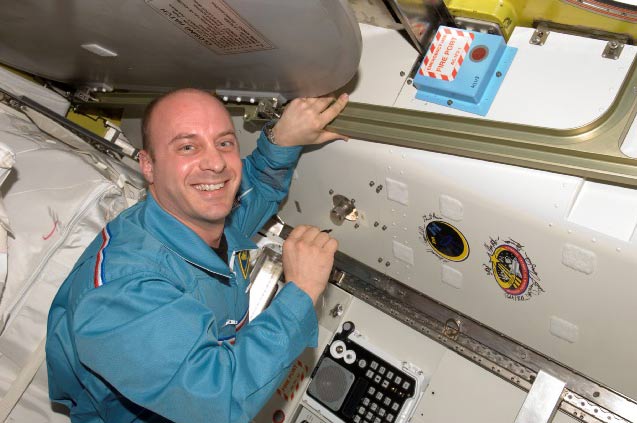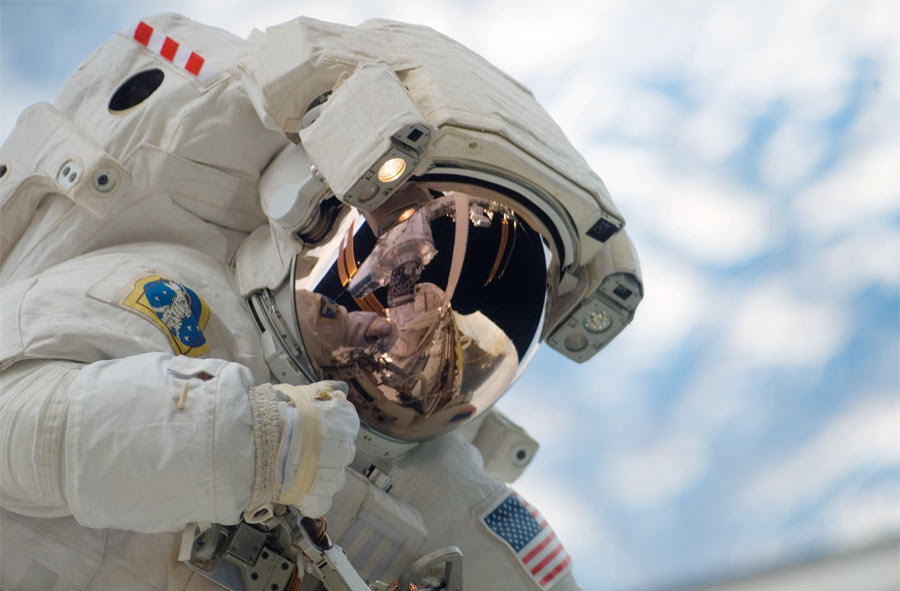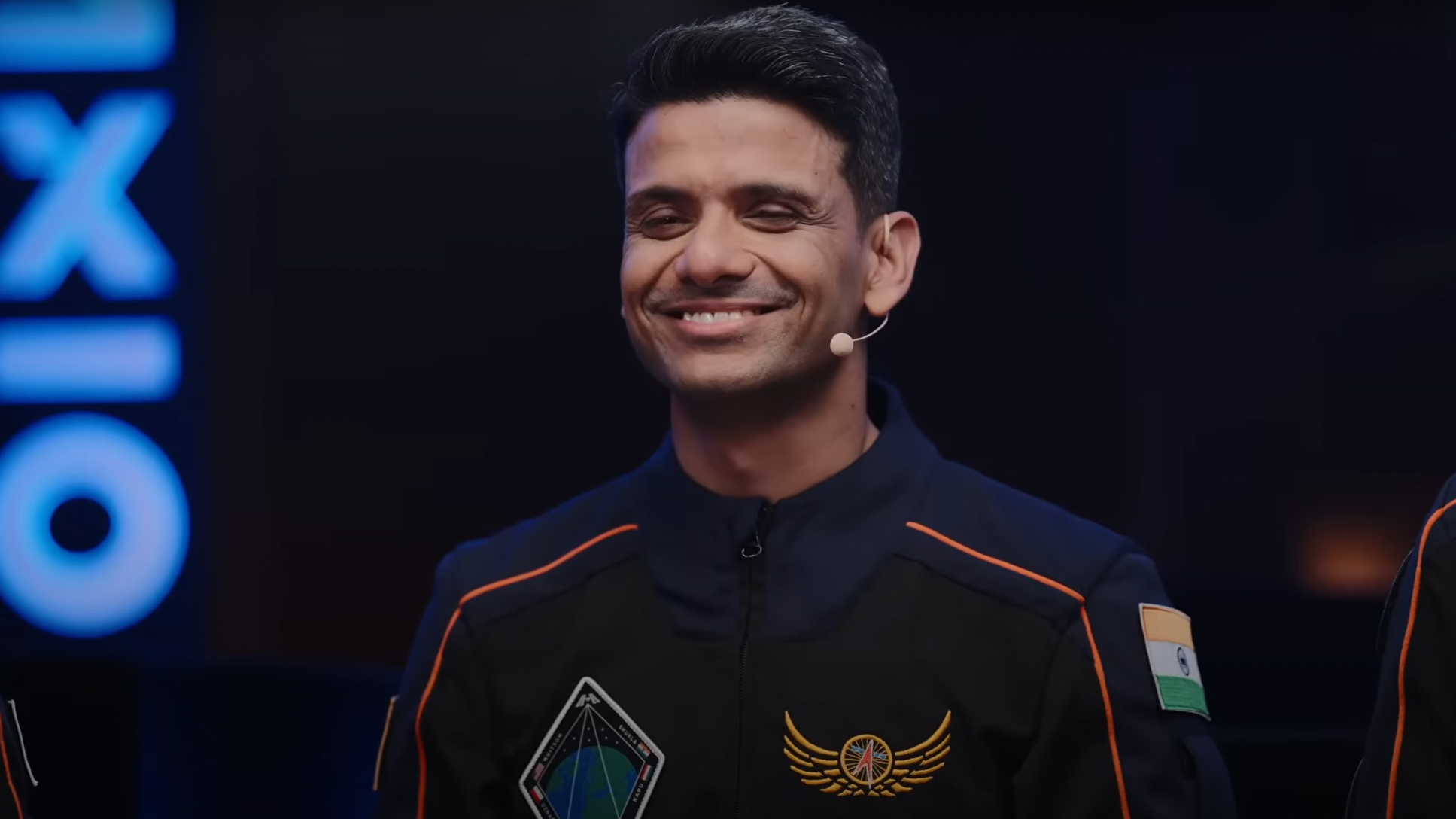Astronaut Garrett Reisman Talks About the Ups and Downs of Space

Former NASA astronaut Garrett Reisman spoke to a packed ballroom of fans at Atlanta's Dragon Con — a science fiction and fantasy convention — over Labor Day. The explorer peppered his talk with humor, often picking on himself, but also conveyed the joy and wonder of traveling to space.
From the start, Reisman set the tone by assuring the audience that he was, in fact, a real astronaut. A large number of the over 80,000 Dragon Con attendees come dressed as characters from favorite movies, books or television shows, and Reisman, who was dressed in his blue flight suit, could have easily been just another cosplayer.
"People keep asking me what episode I am on, what show," Reisman said. "If I played an astronaut on TV, I'd be a lot taller and a lot better looking."
Reisman spent 107 days in space over the course of two missions and performed three EVAs (extravehicular activities) or spacewalks. In 2008, he launched aboard the space shuttle Endeavor to spend three months on the International Space Station.
"The truth is, being up there for 95 days is kind of disappointing," Reisman joked. "Because if you stay up for 100 days, you get a patch." After his second mission, which lasted almost two weeks, he said he came down ready for his patch, having reached over 100 days in total. "I had my hand out for my patch, and they were like, 'No! It's got to be 100 days in a row.'"
He went on to joke about the spot on his uniform where the patch would go, had he received one. "You see this big empty hole over my heart," he said.
Joking aside, "Being up in space for 95 days was super-cool," he said. "If you're in space and you're not having fun, something's wrong with you."
Get the Space.com Newsletter
Breaking space news, the latest updates on rocket launches, skywatching events and more!
Going somewhere in a hurry
Reisman walked the audience through NASA's launch procedure for a space shuttle mission. He displayed a photograph of the massive rocket that carried the shuttle into space.
"It is alive. It is full of liquid hydrogen and liquid oxygen — which is why most of the sane people stand at least 5 miles [8 kilometers] away," he said.
Pointing to a recess in the tower supporting the walkway to the shuttle, he said, "That, ladies and gentlemen, is the last bathroom on Earth. You make sure you take that opportunity, because the next one's not coming along for a while."
When strapped into the rocket, astronauts don't hear the countdown clock, he revealed. Instead, they hear a bunch of operational events, such as notifications that the navigational systems are aligned or that the engines have come up. As the main engines come online, the shuttle begins vibrating, he said.
According to Reisman, the only thing holding the launch vehicle to the tower are four bolts on each of the two solid rocket boosters. After the human-head-sized nuts attaching the bolts fall into the sand pit beneath, they are picked up and turned into book-ends with a plaque that astronauts can put on their shelves.
With its engines burning, the shuttle then strains forward, trying to break free but held down by the rockets. As it slowly tips back, a large explosion announces the lighting of the solid engines.
"When those eight bolts let go, you're going somewhere in a hurry," Reisman said. "You leap off the pad, and by the time you clear the tower, you're going over 100 mph [160 km/h]."
The noise and vibration is noticeable but "not super-crazy," he said. In many ways, it's similar to the astronaut-experience ride at the visitor's center at Florida's Cape Canaveral, Reisman said, though the ride doesn't subject riders to the same gravitational forces.
"You pull up to 3 g's during launch," he said. Each "g" is equal to the force the human body normally feels while resting on Earth, so at 3 g's, astronauts feel three times as heavy. During training, astronauts are put into a centrifuge to simulate increased g's, and Reisman said he regularly experienced the same amount of acceleration while training. "The difference [during flight] is that it goes on for a while," he said.
The astronaut said the shuttle travels from a dead stop to 17,500 mph (28 km/h) in 8 and a half minutes.
"There is no other accel[eration] like that," he said.
Then, suddenly, it's over. The engines shut off, and you're no longer accelerating.
"You instinctively put up your arms, because you're afraid you're going to be a bug on the windshield," he said. But because you aren't coming to a stop — you've just stopped accelerating — you don't actually fly forward. "In a moment, you feel really silly," Reisman said. "And then you're up in space."
A new view of Earth
Astronauts aboard the shuttle and the space station are privy to a view of Earth that few people are fortunate enough to see in person. But these astronauts don't get that glimpse immediately. Reisman said he was in space, working on a variety of housekeeping issues, before he could take a look at his home planet from afar. There's only one window on the Endeavor, he said. Roughly the size of a dinner plate, it was tucked in a corner on the hatch.
"I see this pale blue glow from that window and think, this is going to be mind-blowing," Reisman told the rapt audience. He said he took a moment to pause, meditating on what he was sure would be a life-changing experience. Then he floated over to the window and looked down on his planet from above.
"What I felt, deep inside me of me, could best be described as 'meh,'" Reisman said, only partially joking. Long before his journey into space, he had seen detailed images of the planet taken by satellites and other astronauts. High-definition images had spoiled him, he said. "I'm worried that these space tourists are going to go up [in the future] and be disappointed."
While the view of the planet didn't grab his attention, he found himself impressed by the thin ribbon of atmosphere hovering above it. "It looks terribly fragile, like a gust of wind could come by and blow it all away," he said.
Between the surface and space lies a thin margin containing all the things necessary for life. "The part that matters to us [humans] is actually really small," Reisman said. Its finite nature raised concerns for the astronaut.
"It gives the impression that, hey, it's small enough that we are perfectly capable of messing it up — in fact, we have been messing it up for…years," Reisman said. "We've got to stop that, because this is the only spaceship we've got."
"If you're the crew on the spaceship and you totally blow off the life support system, bad things are going to happen," he said.
The daily commute
While his hovering view may have brought some things into focus, Resiman's time in space wasn't all serious. He said one of the most fun things to do in space is playing around in microgravity.
"We call it floating, but it's really flying," he said. "And that's how you commute to work!"
Each morning, he would push out of his sleeping bag and fly through the air to the surface module. While videos make it look effortless, he joked that they don't show the first few takes of him banging his head in the process. But that didn't make the experience any less enjoyable, he said.
"It was as much fun on day 95 as it was on day 1," he said.
When asked if the changes in gravity affected snoring, Reisman said he couldn't definitively answer. He claimed he never heard his colleagues snoring in space, but said various sounds on the space station could have covered the noise.
But the most incredible experience by far was being outside the station for space walks, he said.
"It was freaking awesome," Reisman said.
From the start, it wasn't certain that the astronaut would be permitted to engage in any EVAs. At 5 foot 4 inches [1.6 meters] tall, he is shorter than many other astronauts, he said. When he arrived in Houston to train in the enormous pool at NASA's Johnson Space Facility, he found that he was "definitely at a disadvantage … But I worked at it. I didn't give up."

Over time, he found that he needed to use different body positions to accomplish tasks designed for taller astronauts. He used different settings on the foot restraints. Eventually, all that hard work paid off; he performed three space walks over the course of his two missions, using the reflection in his helmet to take a selfie with Earth during one of them.
And going to space helped his height. Without gravity compressing the spine, astronauts tend to return home a little taller than they were when they left.
"I grew almost exactly one inch," Reisman said. [The Human Body in Space: 6 Weird Facts]
A sci-fi fan in space
Life on the ISS came with a lot of perks. While in space, Reisman took photographs of his favorite baseball stadiums. "It was like going on safari," he said.
He also spent time in space watching "Battlestar Galactica," a science-fiction show whose mention resonated with the geeky audience at Dragon Con. He said that he turned off the lights and watched the show by the gleam of the LEDs, with Earth out the window. "[Space is] the coolest place to watch 'Battlestar Galactica,'" he said.
After he returned to Earth, Reisman was invited to the taping of the show's final episode, and even played a role as a colonial marine. "It doesn't end well [for my character]," he said.
Show producer Ron Moore gave Reisman a model of a Viper, a fighter spacecraft from the series, and while in space on his second mission, the astronaut made a video of Viper "flying" in front of the window above Earth.
Missing home
Not everything in space was fantastic, he said. "You don't go to space for the food," he said. U.S. astronauts' food supplies are based off of military food packets, which are well-known for their tastelessness, Reisman said. Because crumbs can fly off and cause problems, astronauts aren't allowed to have bread or other messy foods.
"Man, I wanted a pizza so bad," Reisman said.
The Russian meals tasted better than their American counterparts, he said, but their presentation could be a problem. Reisman said the Russian meals all came in cans. "It looked a lot like dog food," he said.
Reisman had another disappointing fact for his audience.
"We don't actually eat astronaut ice cream," he said.
The Russian side of the space station is smaller than the U.S. side. Reisman said that's because both were limited by the vehicles that carried the modules into space. While the U.S. side is smooth and shiny, the Russian region is covered in felt, so that anything with Velcro can be easily attached to a surface and kept from floating away.
"On the other hand, when you spill your fruit punch, they name a stain after you," Reisman joked.
The difference in radiation shielding between the two sides was most apparent when he closed his eyes, he said. As radiation passes through the lids to hit the eyeballs, it fires off what look like bolts of lightning. On the well-shielded U.S. side, those bolts would come sporadically every few seconds. They're far more common in the other module.
"On the Russian side, it's like the Fourth of July," Reisman said.
Looking forward
In 2011, Reisman left NASA to start work at SpaceX, a private company designing reusable rockets with the goal of bringing down the cost of space travel.
After talking about how impressed he was that SpaceX was the first private company to launch something into orbit and bring it safely back down, he said, "But what really impressed me was the price tag." Admitting that the $300 million cost was beyond his personal budget, he reminded the audience that this cost included the rocket, personnel, spacecraft, test facility and other things, compared to NASA's $1.6 billion tag for each shuttle launch.
SpaceX is opening up a whole new future, Reisman said. "The key to that future is reusability."
Solid-fuel rockets were dropped in the ocean after launch because refurbishing cost more than purchasing new ones, he said. With the space shuttle, the crew and cargo vehicle was at least reusable, but Reisman said the shuttle and its launching process was "too complicated" to make reusable.
As a private company, SpaceX can also make and carry out decisions much faster than a government agency like NASA can, Reisman said.
"The fastest path towards making the best decision is to make a decision today," he said. "At NASA, you don't have that option."
He was quick to point out that SpaceX wouldn't be nearly as successful without NASA's help. "It's been a really good partnership," he said.
As for the Falcon Heavy, SpaceX’s newest megarocket, Reisman said the company had just tested all three cores of the first stage. It will be assembled in Florida, where the rocket will undergo more testing and a few modifications. It should be ready for flight by November or December, he said.
"When that rocket launches, it's going to be awesome," He said.
By making spaceflight cheaper, SpaceX is making space more accessible to a wider range of people, Reisman said.
"We're about to start a golden age of spaceflight," Reisman said. "It's only beginning. Stay tuned. It's going to be awesome."
Follow Nola Taylor Redd on Twitter @NolaTRedd or Google+. Follow us at @Spacedotcom, Facebookor Google+. Originally published on Space.com.
Join our Space Forums to keep talking space on the latest missions, night sky and more! And if you have a news tip, correction or comment, let us know at: community@space.com.

Nola Taylor Tillman is a contributing writer for Space.com. She loves all things space and astronomy-related, and always wants to learn more. She has a Bachelor's degree in English and Astrophysics from Agnes Scott College and served as an intern at Sky & Telescope magazine. She loves to speak to groups on astronomy-related subjects. She lives with her husband in Atlanta, Georgia. Follow her on Bluesky at @astrowriter.social.bluesky
